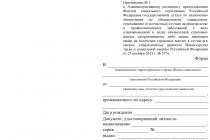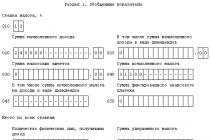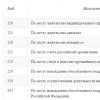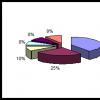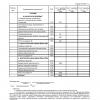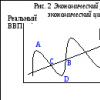The book of income and expenses is the main tool for accounting for transactions performed in the course of activities on the simplified tax system, related to tax registers. It is required to conduct it only by persons working in a simplified mode - individual entrepreneurs and organizations. Such an obligation is reflected in Article 346.26 of the Tax Code of the Russian Federation.
How to keep a book of income and expenses?
For each year, a separate register is opened in the form fixed by the Ministry of Finance in order No. 135n dated 10/22/12, from the start of doing business on the simplified tax system.
There are two bookkeeping methods available:
- In paper form - all records of transactions are made manually with a pen. The book must be prepared to a usable condition, for this the pages of the register are collected in the form of a journal, stitched, numbered, a note is made on the last sheet about the total number of sheets with fixing this entry with the signature of the head and the seal;
- In electronic form - during the year, entries are made in the electronic format of the book, at the end of the year it is printed, the pages are stapled, numbered, their total number is indicated on the last page of the journal with the signature of the head and the seal of the company.
You can switch from one form of keeping the Book to another at any time.
Since the Book of Accounts is a tax register, that is, it is used to calculate the tax burden under the simplified tax system, it is necessary to enter into it only those income and expenditure indicators that will be taken into account when calculating the base for a special simplified tax.
The essence of maintaining the Book is to sequentially record each operation, which resulted in income or expense, in the tabular part of the register. The entry is made on the date when this income or expense is recognized as such, indicating the details of the supporting primary documentation.
Information about the operation is entered in the Book of Accounts only if there is a source document supporting it. If there is no document, then it is impossible to fix the amount in the register.
There is no need to submit the Book anywhere, it is not attached to the USN declaration, but it must be available. If the tax authorities want to get acquainted with this register and send a request for its provision, then the "simplifier" is obliged to do this in order to avoid penalties.
If the company has separate subdivisions, then the Book of Accounts is maintained by the taxpayer, which in this case is the parent company. The Book reflects the general summary data without division into divisions.
Features of filling out the book of accounting for income and expenses
The procedure for filling out the Book depends on the chosen object of taxation:
- Income - section I (columns 1-4) and section IV are filled in (contributions and sick leave are reflected);
- Income / expenses - section I and a certificate to it are filled out, section II (in relation to fixed assets costs), section III (to account for the loss of previous years).
The register contains data on each transaction performed during the year, which resulted in the appearance of income or expense that is taken into account for taxation. Entries are made in chronological order without division into separate types of activities. Data on each transaction must be entered on a separate line, regardless of the date of receipt of income or expense.
The primary document on the basis of which an entry is made can be an accounting form confirming the fact of receipt of income or expense.
The Ministry of Finance, in its letter, recommends entering cost indicators in full rubles, however, data is transferred to the USN declaration itself without rounding, taking into account kopecks, and therefore it is more convenient to enter amounts with kopecks, which will simplify subsequent reporting.
Filling out the Book with the simplified tax system "income"
Taxpayers who have chosen the amount of income for taxation must reflect in the Book of Accounts:
- Income subject to special tax USN (section I gr. 1-4);
- Expenses in the form of insurance contributions and compensations for sick leave, reducing the tax payable (Section IV);
- Expenses made at the expense of financing within the framework of state support for small businesses (section I, column 5).
In addition, you need to fill out the title page of the Book, indicating the basic information about the taxpayer, the object of taxation, address and bank account numbers.
What you need to fill in the "simplified" with the object of taxation "income":
| Chapter | Count | Explanations for filling |
| I | 1 | Ordinal number of the line. |
| 2 | Details of the primary document confirming the transaction. | |
| 3 | The essence of the operation - a brief description. | |
| 4 | The amount of income received. The entry is made at the time of income recognition. The data is filled in sequentially. Based on the results of each quarter and the reporting period, the results of the total amount of income are summed up. |
|
| IV | 1 | The serial number of the line to indicate data on the cost of paying contributions and sick leave. |
| 2 | Information about the primary document confirming payment (name, number, date). | |
| 3 | The period for which the amount of contributions or hospital benefits was paid (month, year). | |
| 4 | The amount of pension contributions. | |
| 5 | The amount of social contributions in connection with motherhood. | |
| 6 | The amount of medical contributions. | |
| 7 | The amount of social contributions from accidents and occupational diseases. | |
| 8 | Compensation for sick leave paid at the expense of the employer. | |
| 9 | Voluntary insurance payments. | |
| 10 | The total amount for the line. Data are given for each quarter, reporting period. |
Filling out the Accounting Book under the simplified tax system "income-expenses"
If the "simplistic" decides to tax the difference between the amount of income and expenses incurred, then you need to fill out the Book a little differently.
The company must record in the register:
- Income and expenses from activities taken into account when calculating the special tax of the simplified tax system (Section I);
- Certificate for Section I (filled in at the end of the year);
- Costs of intangible assets and fixed assets paid for, used in simplified activities (section II, a new section is filled out for each reporting period, the name of the period is indicated at the top of the section);
- Loss of past tax periods (section III).
The title page is also filled in, on which you need to write your name (full name for individual entrepreneurs), basic details, address, selected object of taxation and numbers of existing bank accounts.
What you need to fill in the "simplified" with the object "income-expenses":
| Chapter | Count | Explanations for filling |
| I | 1 | record number. |
| 2 | Date and number of the primary accounting document confirming the fact of the transaction. | |
| 3 | A description of the transaction in which the expense or income was received. | |
| 4 | The amount of income from the operation. | |
| 5 | The amount of the transaction expense. | |
| Total | The results are summed up by quarters and by periods since the beginning of the year (total values of income and expenditure indicators) | |
| Reference | 010 | The total amount of income for the year, taken into account in the taxable base. |
| 020 | The total amount of expenses for the year, which reduces the amount of income for tax purposes. | |
| 030 | The result of the difference between the minimum tax paid for the previous year and the calculated tax for the same year. The data is taken from the USN declaration for the past year - the difference between lines 270 and 260 of the second section. | |
| 040 | Base for calculating the special tax (indicators of lines 010 - 020 - 030). Only a positive result is indicated. | |
| 041 | The amount of losses for the year (indicators of lines 020 + 030 - 010). Only a positive result is indicated. | |
| II | 1 | Record number of the second section in order. |
| 2 | The name of the asset according to documentary data. | |
| 3 | Date, month and year of payment, only paid expenses can be taken into account. Data is entered on the basis of payment documents. | |
| 4 | Date of submission of documentation for state registration of fixed assets, if such a procedure is required. | |
| 5 | Date of acceptance for accounting of the asset (commissioning). | |
| 6 | The initial cost of the object (the amount of expenses). If the expenses were incurred before the application of the simplified tax system, then you do not need to fill out the column. | |
| 7 | The useful life of an asset. | |
| 8 | The residual value of an object acquired before the start of the application of the simplified tax system (determined on the date of transition to the "simplification"). If the expenses were made during the simplified tax system, then the column is not filled out. | |
| 9 | The number of quarters of operation of the facility in the current year. | |
| 10 | The share of the cost in%, which is taken into expenses for the year (for assets acquired on the simplified tax system, 100 is indicated, for assets acquired before the simplified tax system, 50 is set in the 1st year, 30 in the 2nd, 20 in the 3rd ). | |
| 11 | A similar indicator in the context of a quarter is defined as the value of column 10 divided by the value of column 9. | |
| 12, 13 | The amount of costs for fixed assets or intangible assets taken into account when calculating the single tax simplified tax system for each quarter and year. | |
| 14 | Costs expensed in past periods. Not filled in for assets acquired on the simplified tax system. | |
| 15 | Costs that will be taken into account in the following periods (column 8 - 13 - 14). Not filled in for assets acquired on the simplified tax system. | |
| 16 | The moment of departure. |
Section III contains data on losses from activities in previous years that have not been transferred to the beginning of the previous year. These amounts may reduce the basis for tax calculation. Data for the last 10 years are taken into account.
Responsibility for the "simplifier"
An individual entrepreneur or legal entity on the simplified tax system is required to keep the above book according to the established form, since its indicators are used to calculate the tax burden.
Responsibility in the form of a fine will come under Article 120 of the Tax Code of the Russian Federation if the "simplifier":
- Will not maintain this register;
- Will conduct it in violation of the Filling Order;
- Will make transactions on the wrong date.
When determining the amount of the fine, one must proceed from the results obtained as a result of these violations:
- if the base for the USN tax is underestimated, then you will have to pay 20% of the amount of unpaid tax, while the minimum fine is limited to 40,000 rubles;
- if the base is not underestimated, then the fine will be from 10,000 to 30,000 rubles.
An additional fine will be imposed if, at the request of the tax during the audit, the “simplifier” cannot present this tax register. In this case, you will have to pay 200 rubles. for each unprovided book. In addition, a fine can be imposed on a specific employee in the amount of 300 to 500 rubles.
A company on the simplified tax system must not only have and correctly fill out the Book of Accounting for Income and Expenses, but also store it properly for 4 years preceding the current year.
That is, if necessary, the “simplistic person” must present completed books for the last four years to the tax authorities.
Correction of the Book of Accounts
If an error is found in the electronic form of the Book, then you can make a correction by deleting the existing incorrect entry and making the correct one.
If an error is detected in paper form or after printing out an electronic format, then editing the record is carried out by carefully crossing out the incorrect data with one thin line. Correct information is written next to it, the head's signature and a seal imprint, if any, are put.
It is impossible to correct incorrect data with correctors of various types.
Organizations and individual entrepreneurs that apply the simplified taxation system are required to keep tax records of their income, and sometimes expenses, in a special book. We will tell you about the Book of Accounting for Income and Expenses under the simplified tax system in 2019 in our consultation.
How to conduct KUDiR
The form of the Book of Accounting for Income and Expenses of Organizations and Individual Entrepreneurs Using the Simplified Taxation System (KUDiR), as well as the Procedure for filling it out, were approved by Order of the Ministry of Finance of Russia dated October 22, 2012 No. 135n. The book of income and expenses for individual entrepreneurs on the simplified tax system or organizations in Excel format can be found at the link below.
Filling out KUDiR with the simplified tax system "income minus expenses"
When maintaining a book of income and expenses under the simplified tax system, it is necessary to be guided by the Procedure for filling out the KUDiR, which is given in Appendix No. 2 to the Order of the Ministry of Finance of Russia dated October 22, 2012 No. 135n.
This Procedure provides explanations for KUDiR on how to fill out certain sections with the simplified tax system “income minus expenses”. Naturally, simplistic people with the “income” object will also find answers to the questions of filling out their “cut-down” book: we recall that income simplistic people may not reflect information about their expenses in KUDiR.
For example, for expenses in KUDiR under the simplified tax system, the information in Section I “Income and expenses” is filled in as follows:
- in column 1 "No. p / p" it is necessary to indicate the serial number of the registered operation;
- column 2 "Date and number of the primary document" contains the date and number of the primary document, on the basis of which the debit transaction is registered;
- in column 3 "Content of the operation" the content of the business transaction is entered, for which the cost of the simplified tax system is taken into account;
- in column 5 “Expenses taken into account when calculating the tax base (rubles)”, the simplified clerk lists the expenses incurred and paid by him, which are indicated in paragraph 1 of Art. 346.16 of the Tax Code of the Russian Federation.
As a rule, payment orders act as the primary document, because income and expenses are recognized on the simplified tax system on a cash basis (clauses 1.2 of article 346.17 of the Tax Code of the Russian Federation).
The form of the book of accounting for income and expenses from 2018
From 01/01/2018, organizations and individual entrepreneurs on the simplified tax system apply an updated book of accounting for income and expenses (amendments were made to it
KUDiR - a book of accounting for income and expenses.
KUDiR, stitched and numbered (See here ""), should be in any case, even if the activity is not carried out (although in practice many do not do this).
Penalty for the absence of a book: individual entrepreneurs - 200 rubles, organizations - 10,000 rubles.
Apply: individual entrepreneurs and organizations on OSNO, USN, ESHN, PSN. Taxpayers on UTII do not conduct KUDiR!
Since 2013, it is not necessary to certify income and expenses in the tax book.
Correction of errors when maintaining the Book by hand must be justified and confirmed by the signature of the individual entrepreneur or the head of the organization, indicating the date of correction and the seal (for individual entrepreneurs - if any).
All transactions are reflected in chronological order based on supporting documents (agreement, invoice, check, etc.).
In each new tax period - a new KUDiR.
If you keep a book in electronic form, then at the end of the tax period, print it, number it and flash it (how to flash it - the link is given above), and seal it with a signature. Blank sections are also printed and stapled to maintain the integrity of the KUDiR.
We will consider the instruction on the KUDiR form for the USN, but this filling is also suitable for the ESHN forms and the patent, because. forms are almost the same.
KUDiR can also be simplified in this automated way.
Title page
Field "Form according to OKUD" is not filled.
Field "Date (year, month, day)". Specify the start date for the bookkeeping.
Field "According to OKPO". Not required to fill out. OKPO can be viewed in a letter from Rosstat (if received during registration), or on the OKPO.ru website.
Field "Object of taxation". Enter "income" or "income minus expenses".
And also indicate the rest of the data (settlement account - if available, full name, name of the organization, necessary addresses).
Section 1. Income and expenses
GRAPH 1. Sequence number of the entry.
GRAPH 2. Date and number of the primary document on the basis of which the income was received or the expense was made.
REGISTRATION OF INCOME IN COLUMN 2
1) Cash receipts - we write the date of arrival and the number of the Z-report, which you usually remove at the end of the working day. Example: 01/10/2015 check Z-report No. 4545.
2) Receipts to the current account - write the date of arrival and the number of the payment order, or bank statement. Example: 01/10/2015 p / p No. 45 or bank statement dated 01/10/2015 No. 45.
3) BSO revenue (strict reporting form) - if several BSOs are issued during the day, then it would be reasonable to draw up a PKO () on them, which will indicate the numbers of all used BSOs. This PKO is entered in KUDiR. But it is not allowed to make one entry in KUDiR on the basis of several BSOs issued on different dates. Sample:
4) Return. Suppose you need to return the overpaid amount or return the prepayment to the buyer upon termination of the contract. In this case, we enter the refund amount in column 4 (income) with a minus sign.
- Incomes are indicated by the actual date of receipt of funds and property.
- Also, funds and property can be received on the basis of other documents (consignment note, act of acceptance and transfer of property, etc.).
RECORDING EXPENSES IN COLUMN 2 (only for the simplified tax system "income minus expenses")
We write the date of the expense and the number of the document (for example, a cash or sales receipt, a payment order, an expense cash warrant, a Z-report, etc.).
GRAPH 3. Specify the content of the registered operation.
REGISTRATION OF INCOME IN COLUMN 3
Replenishment of own account and increase in authorized capital is not considered income,
Therefore, it is not included in KUDiR.
1) An example of recording income:


HOW TO MAKE A REFUND?
Suppose you need to return the overpaid amount or return the prepayment to the buyer upon termination of the contract. In this case, we enter the refund amount in column 4 (income) with a minus sign.
Return record example:


RECORDING EXPENSES IN COLUMN 3 (only for the simplified tax system "income minus expenses")
1) An example of a record of the issued salary and personal income tax.


2) The cost of purchasing goods is indicated only after its sale.
An example of such an entry:
I decided to sell laptops for 20,000 rubles. - 1 PC.


GRAPH 4. Specify the amount of income taken into account when calculating tax.
GRAPH 5. Specify the amount of expenses taken into account when calculating tax.
It is filled in only by those who are on the simplified tax system "income minus expenses".
"REFERENCE TO SECTION 1"
For the simplified tax system "income" - only line 010 is filled in (the amount of income received for the year)
For the simplified tax system "income minus expenses" - lines 010, 020, 030 (if necessary), 040, 041 are filled in. A negative result on lines 040 and 041 is not indicated.
Section 2. Calculation of acquisition costsFixed assets and intangible assets
This section applies only to those who are on the simplified tax system "income minus expenses." To be filled in if there were such expenses in the tax period. For reference:
1) Fixed assets are tangible assets that an individual entrepreneur, an enterprise uses to carry out its activities, and the service life of which is more than 1 year.
Fixed assets can be, for example, industrial buildings, structures, vehicles, equipment, tools, household equipment, etc.
2) Intangible assets - assets that do not have a physical form, with a useful life of more than 12 months. These can be, for example, intellectual property, copyrights, patents for inventions, trademark rights, etc.
Section 3. Calculation of the amount of loss reducingtax base for tax
This section applies only to those who are on the simplified tax system "income minus expenses." It is filled in if there were losses in previous years or in the past year that can be carried forward to the next tax period.
Section 4 Expenses Reducing the Amount of Tax(advance tax payments)
This section is filled out only on the simplified tax system "income". The paid insurance premiums “for themselves” and for employees (if any) are indicated, by the amount of which we reduce the simplified tax system. It's very easy to fill out:
In this case, the sample is filled out for an individual entrepreneur who does not have employees, which means that the simplified tax system can be reduced by the entire amount of insurance premiums paid. We remind you that if an individual entrepreneur has employees, then the tax can be reduced by no more than 50%, by the amount of insurance payments.
For 2014, the individual entrepreneur paid insurance premiums “for himself” in the amount of 20,000 rubles, of which:
In the PFR - 17,000 rubles and in the FFOMS - 3,000 rubles.
Insurance premiums were paid quarterly on an accrual basis in order to reduce the amount of advance payments of the simplified tax system every quarter. If the picture is hard to see, download the KUDiR sample below (Excel format).


All taxpayers using the simplified taxation system (STS) are required to keep a book of income and expenses (KUDiR). If you do not do this, or fill it out incorrectly, you can get a considerable fine (Article 120 of the Tax Code of the Russian Federation). This book is printed and handed over to the tax office at their request. It must be stitched and numbered.
Before you start creating this book of income and expenses in 1C 8.3, check the program settings. If you have problems with the formation of KUDiR and some expenses do not fall into the book, carefully double-check the settings. Most of the problems lie here.
Where is the book of income and expenses 1C 8.3? In the "Main" menu, select the "Settings" section item.
You will see a list of configured accounting policies by organization. Open the position you need.
In the form of setting up an accounting policy at the very bottom, click on the hyperlink "Setting up taxes and reports".

In our example, the “Simplified (income minus expenses)” taxation system is selected.

Now you can go to the "STS" section of this setting and set up the procedure for recognizing income. It is here that it is indicated which transactions reduce the tax base. If you have a question why the expense does not fall into the book of expenses and incomes in 1C, first of all, look at these settings.
Some items cannot be unflagged as they are mandatory. Other flags can be set based on the specifics of your organization.

After setting up the accounting policy, let's move on to setting up the printing of KUDiR itself. To do this, in the "Reports" menu, select the item "Book of income and expenses of the STS" of the "STS" section.
You will see the ledger report form. Click on the "Show Settings" button.

If you need to detail the records of the received report, check the corresponding flag. The rest of the settings are better to check with your tax office, having learned the requirements for the appearance of KUDiR. In different inspections, these requirements may differ.

Filling in KUDiR in 1C: Accounting 3.0
In addition to the correct settings, before the formation of KUDiR, it is necessary to complete all operations for closing the month and check the correct sequence of documents. All expenses are included in this report after they are paid.
The R&D accounting book is generated automatically and quarterly. To do this, click on the "Generate" button in the form where we just made the settings.

The book of income and expenses contains 4 sections:
- Section I This section reflects all income and expenses for the reporting period on a quarterly basis, taking into account the chronological sequence.
- ChapterII. This section is filled out only with the form of the simplified tax system "Income minus expenses". It contains all the costs of fixed assets and intangible assets.
- ChapterIII. It contains losses that reduce the tax base.
- ChapterIV. This section displays amounts that reduce tax, for example, insurance premiums for employees, etc.
If you configured everything correctly, then KUDiR will be formed correctly.
Manual adjustment
If, nevertheless, KUDiR was not filled in quite the way you wanted, its entries can be corrected manually. To do this, in the “Operations” menu, select the item “Entries in the book of income and expenses of the simplified tax system”.

In the opened list form, create a new document. In the header of the new document, fill in the organization (if there are several of them in the program).

This document has three tabs. The first tab corrects entries in section I. The second and third tabs correct entries in section II.
If necessary, make the necessary entries in this document. After that, KUDiR will be formed taking into account these data.
Analysis of the state of accounting
This report can help you visually check the correctness of filling out the book of income and expenses. To open it, select the item "Accounting analysis according to the simplified tax system" in the "Reports" menu.

If the program keeps records for several organizations, you need to select the one for which the report is required in the report header. Also set the period and click on the "Generate" button.

The report is divided into blocks. You can click on each of them to get a breakdown of the amount.
Entrepreneurs who keep records on their own are often in no hurry to use the book of accounting for income and expenses. They explain that since 2013 it does not need to be visaed at the tax office, which means you can do nothing. Nevertheless, it is desirable to keep the book. What is KUDiR, when and by whom is it used? How to maintain and fill out a book of accounting for income and expenses in 2018, read this article.
What is KUDIR?
The book of income and expenses is a diary of the movement of money, which is used in accounting for special tax regimes, such as the simplified taxation system (STS) and PST. Everyone who works on a “simplified” or patent keeps records of income and expenses on its basis. It has its own standards and they cannot be changed. You can fill out the book yourself or entrust the specialists of an outsourcing company, for example, a popular service.
The book is necessary, first of all, to the businessman. To control your profit and not "fly out" of the simplified system. To do this, you need to remember about the restrictions on the amount of income on the simplified tax system. In 2018 - 150 million rubles a year. However, if you have lost the opportunity to use the simplified taxation system and are forced to switch to the general regime, you will need all checks from the beginning of the current quarter. Therefore, it is still better to store and record them in KUDiR.
There are several ways to fill in the KUDiR
Buy in the store book and keep it by hand. In this case, it will have to be numbered, stitched through, stamped, and on the last page stick a label with the words: Stitched-numbered X pages. The sticker is signed by either the director or the entrepreneur.

Electronically. Usually they use tables in Excel or any special service.
A paper KUDiR is drawn up in January, before starting work for the current year. If the book is kept in electronic form, then at the end of the year it is printed out, the number of pages is counted, stitched and stamped. It is recommended to open a new KUDiR for the next calendar year.
You should not put off filling out the Book of Accounts - it is better to spend one hour daily on this than to fall out of the work schedule for a week before submitting reports.
The law requires you to keep KUDiR for four years. With the simplified tax system, the taxpayer can exercise the right to close the losses of previous years or reduce the simplified tax system with the help of a clarification. Therefore, it is more profitable not to throw away 11 years.
Penalties. If the book is missing, then the tax authorities may regard this as a gross violation of the accounting of income and expenses and may impose a penalty in the amount of 100 to 30 thousand rubles. Therefore, if you have not kept a book since the beginning of work, then it is more economical to restore it retroactively on your own or contact the service.
If you didn't work, then you will have a zero KUDiR - the title page is filled in and zeros are put instead of numbers. Zero KUDiR is similarly numbered, stitched and sealed.
How to fill out - general rules
The book is filled out on a cash basis using primary documents. In this case, the income is the time of depositing money into the cash desk or to the current account. That is, all entries are made in turn, and checks, bills and receipts are stored in a folder.
In order not to lose a single document and not to look for errors before submitting reports, entries in the accounting book must be made regularly: this is required by law and common sense. It is enough to allocate half an hour at the end or beginning of the working day to fill out the Book.
In no case should pages be torn out of the book, but it is not forbidden to make changes to the records, it is only necessary to confirm the authenticity of each edit with the signature of the head.

When and by whom is KUDiR used?
KUDiR is led by taxpayers on the simplified tax system - at a rate of 6% with the “Income” object and at a rate of 15% with the “Income minus expenses” object, as well as those who work on a patent and pay a sales tax. In 2018, a new page about the trading fee appeared in the book. Legislators introduced it for the convenience of calculating the simplified tax system in three cities where it is used, namely Moscow, St. Petersburg and Sevastopol.
Previously, the amount of the sales tax was not allocated as a separate line, so it was immediately indicated in the book with a deduction. This complicates the process of calculating the USN. So, how to fill out the book of accounting for income and expenses of an individual entrepreneur under the simplified tax system?
KUDiR for individual entrepreneurs on the simplified tax system 6%
On the USN "Income" (6% rate), the book uses pages 1 - 4 of paragraph I "Income and expenses" and paragraph IV "Insurance and hospital expenses". Sections I and III are not filled out by simplistic people “by income”.
The first three columns are usually not difficult. They rewrite data from primary documents: bank statements, invoices for payment, and others. Let's take a closer look at the last two columns.
In column 4, sequentially indicate all income received on the current account or at the cash desk. Non-operating income is also included here - these are incomes received from the difference in exchange rates, from renting out property, in the form of interest on a loan agreement, and others.

KUDiR for individual entrepreneurs on the simplified tax system 15%
With the simplified tax system “Income minus expenses” (rate 15%), accounting is carried out on the basis of primary documentation: checks, receipts, invoices. But you can't pay all the expenses. The Federal Tax Service has a closed list of expenses on the basis of which tax is reduced.
When filling out the accounting book with the simplified tax system of 15%, the entrepreneur fills in column 5 and pays the expenses specified in the Tax Code of the Russian Federation. Their list is limited and only 37 items.
Unfortunately, the list does not include all costs associated with entrepreneurial activity. For example, the purchase of a refrigerator and microwave for employees cannot be included in expenses. But payment for the online checkout - you can take into account. The main rule is whether these costs help the entrepreneur earn money. After all, you can buy a refrigerator, set it off in consumption and put it in the country. Tax officials monitor such abuses and punish with fines for the deliberate understatement of the taxable amount.
Sample filling KUDiR for IP on USN 15%. IP Martyanov is engaged in the production and sale of children's toys. He bought material and accessories for new dolls in the amount of 230,000 rubles, and then the kindergarten bought toys for 10,000 rubles. And received an advance in the amount of 2000 rubles. In addition, they returned small toys for 20 rubles. In January, Martyanov hired the first employee and paid him a salary of 30,000 rubles. Accrued contributions amounted to 9,000 rubles and personal income tax - 3,900 rubles. Martyanov entered all expenses and incomes in KUDiR.

The cost of pension and health insurance will help reduce tax on the simplified tax system. If these are contributions for the entrepreneur himself, then the tax is reduced to 100%, and if for employees - only 50%.
So, we figured out how to fill out the book of income and expenses of IP. The most important thing is to enter all profitable operations into the book constantly and not to launch. Remember that everything that you have earned is considered income in business, no matter how you received it - in cash, non-cash or mutually. All funds must be indicated in the KUDiR and taxed.
Attached files
- Sample filling KUDiR for IP.xls
- Sample KUDiR for entrepreneurs on USN.xls
- Sample KUDiR for entrepreneurs on PSN.xls
- Sample KUDiR for IP on ESHN.xls







